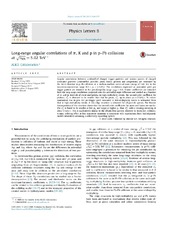Long-range angular correlations of π, K and p in p–Pb collisions at \(\sqrt{s_{NN}}\) = 5.02 TeV
Alme, Johan; Erdal, Hege Austrheim; Helstrup, Håvard; Hetland, Kristin Fanebust; Kileng, Bjarte; Altinpinar, Sedat; Djuvsland, Øystein; Fehlker, Dominik; Haaland, Øystein Senneset; Huang, Meidana; Langøy, Rune; Lien, Jørgen; Lønne, Per-Ivar; Nystrand, Joakim; Rehman, Attiq ur; Røed, Ketil; Røhrich, Dieter; Skjerdal, Kyrre; Ullaland, Kjetil; Wagner, Boris; Yang, Shiming; Bätzing, Paul Christoph; Dordic, Olja; Eyyubova, Gyulnara; Lindal, Svein; Løvhøiden, Gunnar; Milosevic, Jovan; Nilsson, Mads Stormo; Qvigstad, Henrik; Richter, Matthias; Skaali, Toralf Bernhard; Tveter, Trine Spedstad; Wikne, Jon Christopher; Abelev, Betty; Adam, Jaroslav; Adamová, Dagmar; Adare, Andrew Marshall; Aggarwal, Madan M.; Aglieri Rinella, Gianluca; Agocs, Andreas Gabor; Agostinelli, Andrea; Ahammed, Zubayer; Ahmad, Nazeer; Ahmad Masoodi, Arshar; Ahn, Sang Un; Ajaz, Muhammad; Akindinov, Alexander; Aleksandrov, Dimitry; Alessandro, Bruno; Alici, Andrea; ALICE, Collaboration
Peer reviewed, Journal article
Published version

View/
Date
2013-10Metadata
Show full item recordCollections
Original version
https://doi.org/10.1016/j.physletb.2013.08.024Abstract
Angular correlations between unidentified charged trigger particles and various species of charged associated particles (unidentified particles, pions, kaons, protons and antiprotons) are measured by the ALICE detector in p-Pb collisions at a nucleon--nucleon centre-of-mass energy of 5.02 TeV in the transverse-momentum range 0.3 < \(p_T\) < 4 GeV/c. The correlations expressed as associated yield per trigger particle are obtained in the pseudorapidity range |\(\eta_{lab}\)| < 0.8. Fourier coefficients are extracted from the long-range correlations projected onto the azimuthal angle difference and studied as a function of \(p_T\) and in intervals of event multiplicity. In high-multiplicity events, the second-order coefficient for protons, \(v_2^p\), is observed to be smaller than that for pions, \(v_2^\pi\), up to about \(p_T\) = 2 GeV/c. To reduce correlations due to jets, the per-trigger yield measured in low-multiplicity events is subtracted from that in high-multiplicity events. A two-ridge structure is obtained for all particle species. The Fourier decomposition of this structure shows that the second-order coefficients for pions and kaons are similar. The \(v_2^p\) is found to be smaller at low \(p_T\) and larger at higher \(p_T\) than \(v_2^\pi\), with a crossing occurring at about 2 GeV. This is qualitatively similar to the elliptic-flow pattern observed in heavy-ion collisions. A mass ordering effect at low transverse momenta is consistent with expectations from hydrodynamic model calculations assuming a collectively expanding system.
